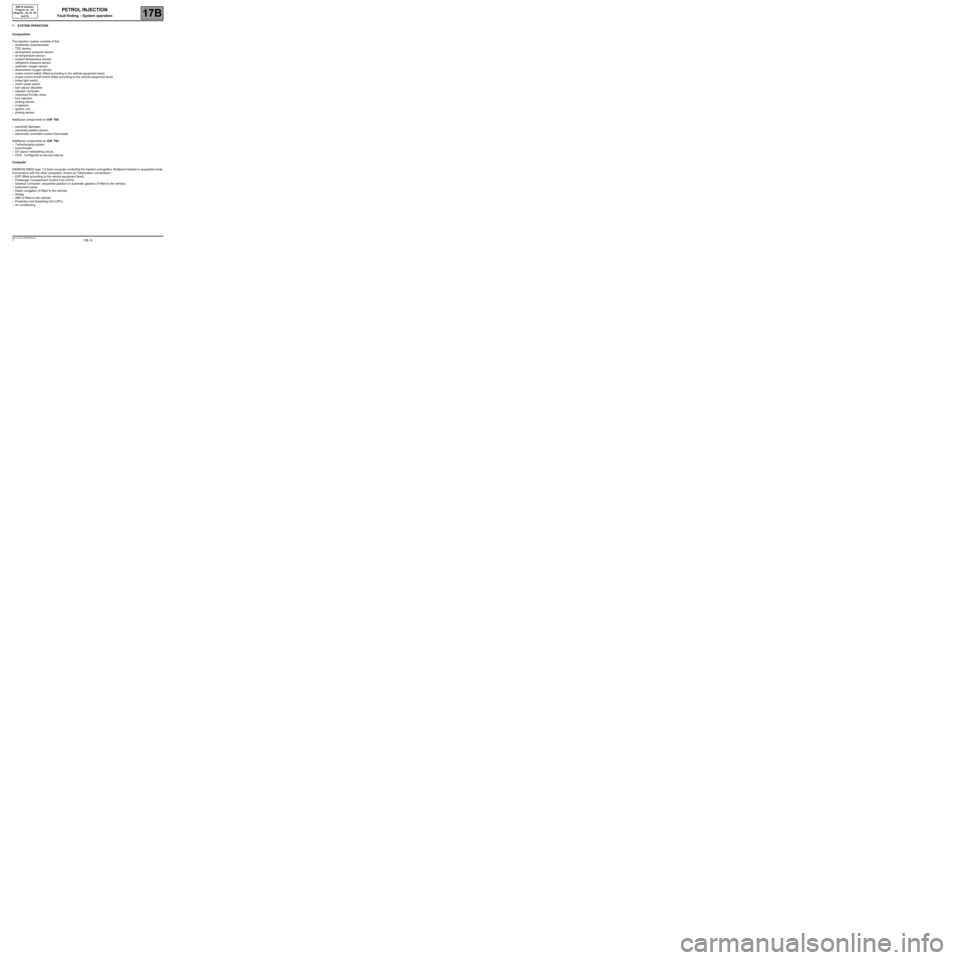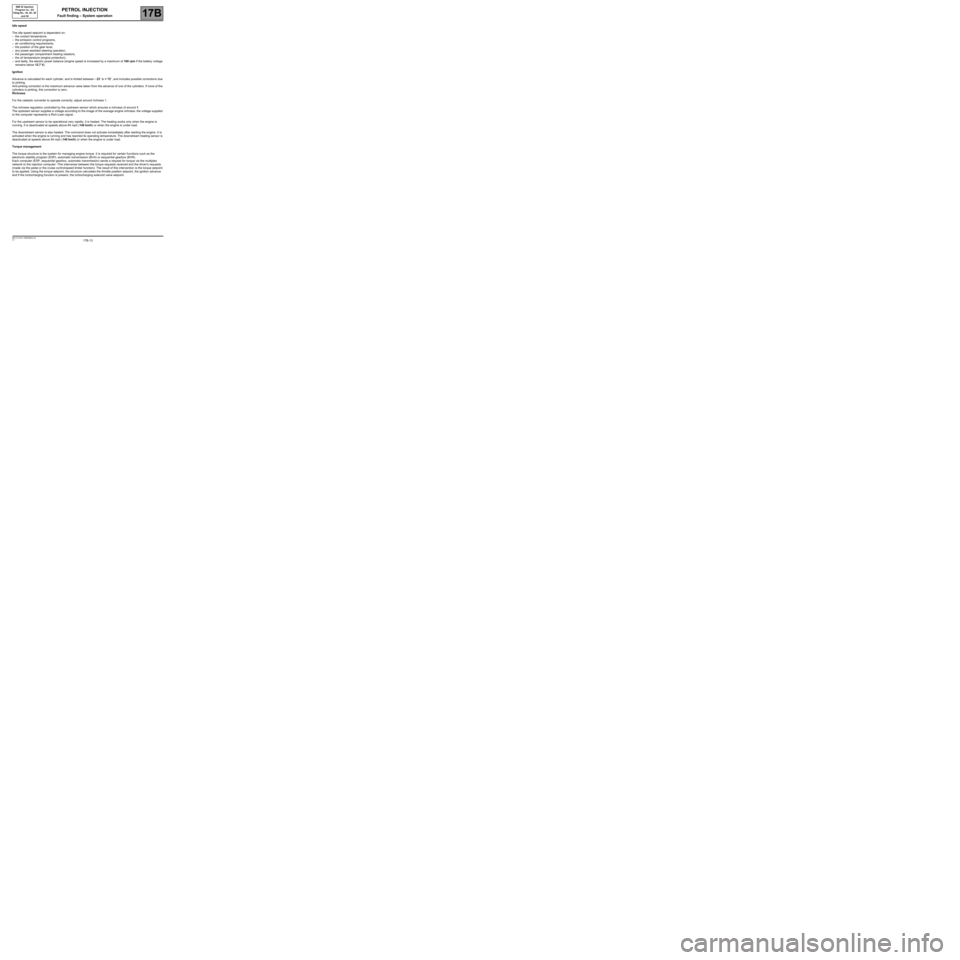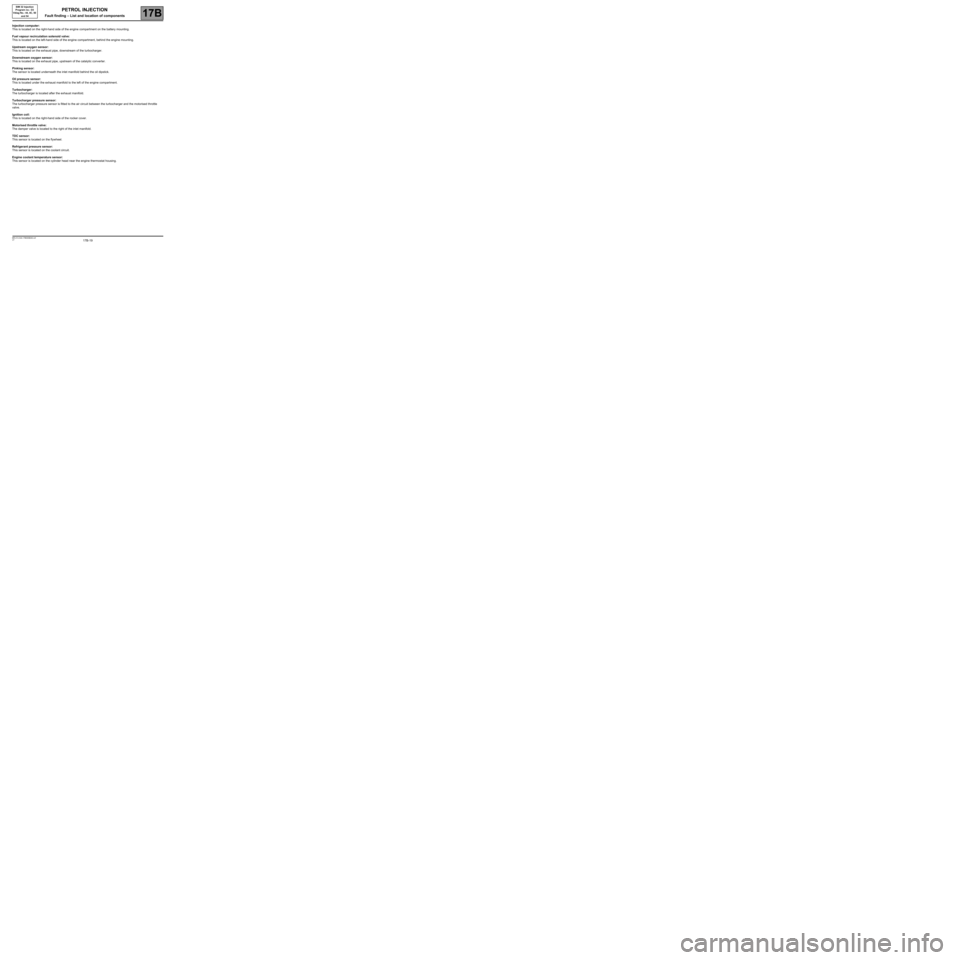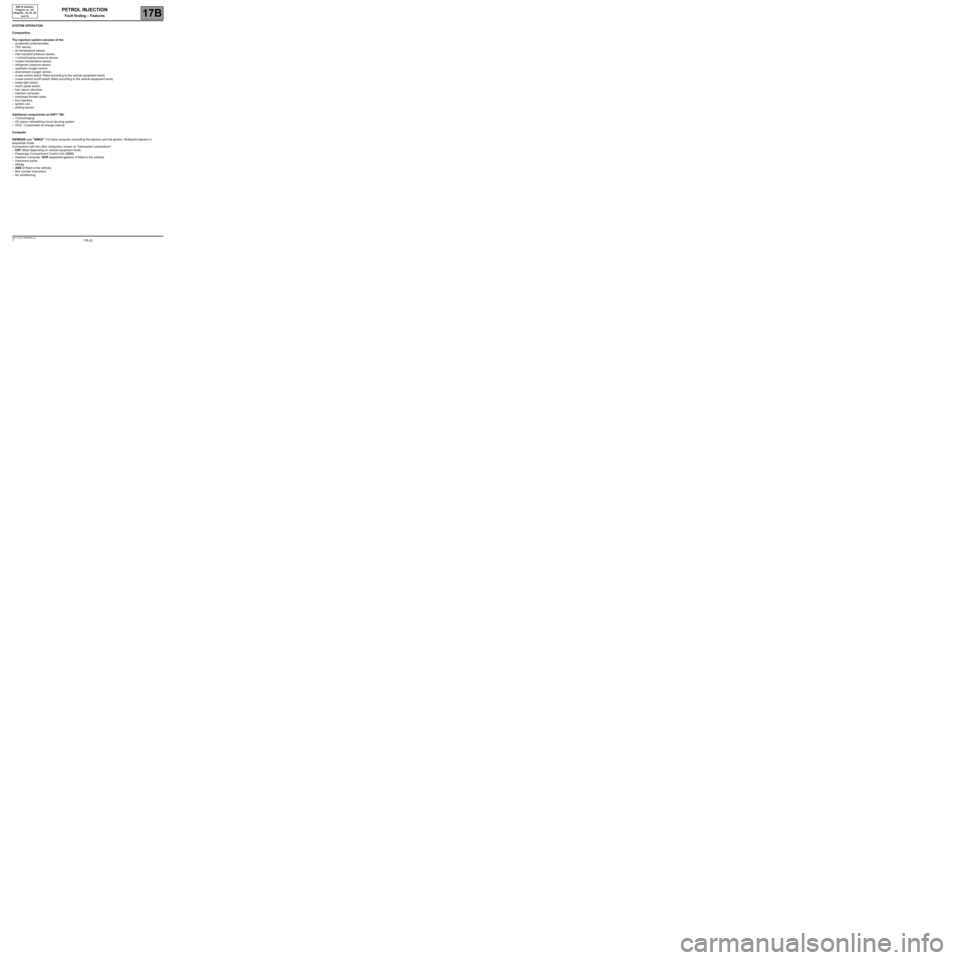2009 RENAULT TWINGO RS oil
[x] Cancel search: oilPage 2 of 348

17B-2V7 MR-413-X44-17B000$010.mif
17B
SIM 32 Injection
Program no.: D3
Vdiag No.: 44, 4C, 50
and 54
1. SCOPE OF THIS DOCUMENT
This document presents the fault finding method applicable to all computers with the following specifications:
2. PREREQUISITES FOR FAULT FINDING
Special tooling requiredVehicle(s): NEW TWINGO, NEW TWINGO RS, E33,
CLIO III, and MODUS
Engine:D7F 800,
D4F 740, 742, 764, 770, 772
D4FT 780, 782, 784, 786
K4M 854, 862
Function concerned: SIEMENS SIM 32 petrol
injection Computer Name: SIEMENS SIM 32 injection
Program No.: D3
Vdiag No.: 44, 4C, 50 and 54
D4F 764: Vdiag 4C or 50
–Camshaft dephaser
–Camshaft position sensor
–Controlled coolant thermostat
D4F 742: Vdiag 50
–Ethanol
–O. C. S. - Customised oil service interval
D4FT 780, 782, 784, 786: Vdiag 54
–Turbocharging
–Oil vapour rebreathing circuit de-icing system
–OCS - Customised oil change interval
–Euro V (782, 786)For applications with Vdiag 50 and 54:
If ET840 = ACTIVE:
–OCS - Customised oil change interval
Documentation type
Fault finding procedures (this document):
●Assisted fault finding (integrated into the diagnostic
tool), Dialogys.
Wiring Diagrams:
●Visu-Schéma (CD-ROM), paper.
Type of diagnostic tools
●CLIP + multiplex line sensor
Special tooling required
Multimeter
Elé. 1681Universal bornier
SIM32_V44_PRELI/SIM32_V4C_PRELI/SIM32_V50_PRELI/SIM32_V54_PRELI
PETROL INJECTION
Fault finding – Introduction
Page 10 of 348

17B-10V7 MR-413-X44-17B000$030.mif
17B
SIM 32 Injection
Program no.: D3
Vdiag No.: 44, 4C, 50
and 54
1. SYSTEM OPERATION
Composition
The injection system consists of the:
–accelerator potentiometer,
–TDC sensor,
–atmospheric pressure sensor,
–air temperature sensor,
–coolant temperature sensor,
–refrigerant pressure sensor,
–upstream oxygen sensor,
–downstream oxygen sensor,
–cruise control switch (fitted according to the vehicle equipment level),
–cruise control on/off switch (fitted according to the vehicle equipment level),
–brake light switch,
–clutch pedal switch,
–fuel vapour absorber,
–injection computer,
–motorised throttle valve,
–four injectors,
–pinking sensor,
–4 injectors,
–ignition coil,
–pinking sensor.
Additional components on D4F 764:
–camshaft dephaser,
–camshaft position sensor,
–electrically controlled coolant thermostat.
Additional components on D4F 784:
–Turbocharging system,
–turbocharger,
–Oil vapour rebreathing circuit,
–OCS - Configured oil service interval.
Computer
SIEMENSSIM32type112-track co mputer controlling the injection a nd ignition. M ultipoint injection in se quential mode.
Connections with the other computers, known as "Intersystem connections":
–ESP (fitted according to the vehicle equipment level).
–Passenger Compartment Control Unit (UCH).
–Gearbox Computer: sequential gearbox or automatic gearbox (if fitted to the vehicle).
–Instrument panel.
–Radio navigation (if fitted to the vehicle).
–Airbag.
–ABS (if fitted to the vehicle).
–Protection and Switching Unit (UPC).
–Air conditioning.
PETROL INJECTION
Fault finding – System operation
Page 13 of 348

17B-13V7 MR-413-X44-17B000$030.mif
PETROL INJECTION
Fault finding – System operation17B
SIM 32 Injection
Program no.: D3
Vdiag No.: 44, 4C, 50
and 54
Idle speed
The idle speed setpoint is dependent on:
–the coolant temperature,
–the emission control programs,
–air conditioning requirements,
–the position of the gear lever,
–any power-assisted steering operation,
–the passenger compartment heating resistors,
–the oil temperature (engine protection),
–and lastly, the electric power balance (engine speed is increased by a maximum of 160 rpm if the battery voltage
remains below 12.7 V).
Ignition
Advance is calculated for each cylinder, and is limited between - 23˚ to + 72˚, and includes possible corrections due
to pinking.
Anti-pinking correction is the maximum advance value taken from the advance of one of the cylinders. If none of the
cylinders is pinking, this correction is zero.
Richness
For the catalytic converter to operate correctly, adjust around richness 1.
The richness regulation controlled by the upstream sensor which ensures a richness of around 1.
The upstream sensor supplies a voltage according to the image of the average engine richness: the voltage supplied
to the computer represents a Rich-Lean signal.
For the upstream sensor to be operational very rapidly, it is heated. The heating works only when the engine is
running. It is deactivated at speeds above 84 mph (140 km/h) or when the engine is under load.
The downstream sensor is also heated. The command does not activate immediately after starting the engine. It is
activated when the engine is running and has reached its operating temperature. The downstream heating sensor is
deactivated at speeds above 84 mph (140 km/h) or when the engine is under load.
Torque management
The torque structure is the system for managing engine torque. It is required for certain functions such as the
electronic stability program (ESP), automatic transmission (BVA) or sequential gearbox (BVR).
Each computer (ESP, sequential gearbox, automatic transmission) sends a request for torque via the multiplex
network to the injection computer. This intervenes between the torque requests received and the driver's requests
(made via the pedal or the cruise control/speed limiter function). The result of this intervention is the torque setpoint
to be applied. Using the torque setpoint, the structure calculates the throttle position setpoint, the ignition advance
and if the turbocharging function is present, the turbocharging solenoid valve setpoint.
Page 19 of 348

17B-19V7 MR-413-X44-17B000$040.mif
17B
SIM 32 Injection
Program no.: D3
Vdiag No.: 44, 4C, 50
and 54
Injection computer:
This is located on the right-hand side of the engine compartment on the battery mounting.
Fuel vapour recirculation solenoid valve:
This is located on the left-hand side of the engine compartment, behind the engine mounting.
Upstream oxygen sensor:
This is located on the exhaust pipe, downstream of the turbocharger.
Downstream oxygen sensor:
This is located on the exhaust pipe, upstream of the catalytic converter.
Pinking sensor:
The sensor is located underneath the inlet manifold behind the oil dipstick.
Oil pressure sensor:
This is located under the exhaust manifold to the left of the engine compartment.
Turbocharger:
The turbocharger is located after the exhaust manifold.
Turbocharger pressure sensor:
The turbocharger pressure sensor is fitted to the air circuit between the turbocharger and the motorised throttle
valve.
Ignition coil:
This is located on the right-hand side of the rocker cover.
Motorised throttle valve:
The damper valve is located to the right of the inlet manifold.
TDC sensor:
This sensor is located on the flywheel.
Refrigerant pressure sensor:
This sensor is located on the coolant circuit.
Engine coolant temperature sensor:
This sensor is located on the cylinder head near the engine thermostat housing.
PETROL INJECTION
Fault finding – List and location of components
Page 22 of 348

17B-22V7 MR-413-X44-17B000$060.mif
17B
SIM 32 Injection
Program no.: D3
Vdiag No.: 44, 4C, 50
and 54
SYSTEM OPERATION
Composition
The injection system consists of the:
–accelerator potentiometer,
–TDC sensor,
–air temperature sensor,
–inlet manifold pressure sensor,
–+ turbocharging pressure sensor,
–coolant temperature sensor,
–refrigerant pressure sensor,
–upstream oxygen sensor,
–downstream oxygen sensor,
–cruise control switch (fitted according to the vehicle equipment level),
–cruise control on/off switch (fitted according to the vehicle equipment level),
–brake light switch,
–clutch pedal switch,
–fuel vapour absorber,
–injection computer,
–motorised throttle valve,
–four injectors,
–ignition coil,
–pinking sensor.
Additional components on D4FT 780:
–Turbocharging
–Oil vapour rebreathing circuit de-icing system
–OCS - Customised oil change interval
Computer
SIEMENS type "SIM32" 112-track computer controlling the injection and the ignition. Multipoint injection in
sequential mode.
Connections with the other computers, known as "Intersystem connections":
–ESP (fitted depending on vehicle equipment level).
–Passenger Compartment Control Unit (UCH).
–Gearbox Computer: BVR sequential gearbox (if fitted to the vehicle).
–Instrument panel.
–Airbag.
–ABS (if fitted to the vehicle).
–Rev counter instrument.
–Air conditioning.
PETROL INJECTION
Fault finding – Features
Page 24 of 348

17B-24V7 MR-413-X44-17B000$060.mif
PETROL INJECTION
Fault finding – Features17B
SIM 32 Injection
Program no.: D3
Vdiag No.: 44, 4C, 50
and 54
Air supply
The idle speed regulator performs all of the calculations that allow the idle speed actuator, the motorised throttle, to
be controlled physically. The functional component of the regulator is adaptive (variation programming and ageing).
If the idle speed regulation conditions are met, the status ET054 Idle speed regulation is "Active", and the idle
speed regulator continually positions the motorised throttle to maintain the engine speed at its idle reference value.
The motorised throttle opening ratio necessary to comply with the speed setpoint is then given by parameter PR091
Idle speed regulation theoretical OCR*.
The PR090 Idle speed regulation programming value is a stored parameter designed to program engine
variations and engine wear and tear for the idle speed regulator. The programming is carried out only when the
engine is idle and warm, and no electrical consumer (air conditioning, fan assembly, power assisted steering) is
operating. Therefore it adjusts slowly.
Idle speed
The idle speed setpoint is dependent on:
–the coolant temperature,
–the emission control programs,
–air conditioning requirements,
–the position of the gear lever,
–any power-assisted steering operation,
–the passenger compartment heating resistors,
–the oil temperature (engine protection),
–the electric power balance (engine speed is increased by 160 rpm maximum if the battery voltage remains below
12.7 V).
Ignition
Advance is calculated for each cylinder, and is limited between - 23˚ to + 72˚, and includes possible corrections due
to pinking.
Anti-pinking correction is the maximum advance value taken from the advance of one of the cylinders. If none of the
cylinders is pinking, this correction is zero.
Page 26 of 348

17B-26V7 MR-413-X44-17B000$060.mif
PETROL INJECTION
Fault finding – Features17B
SIM 32 Injection
Program no.: D3
Vdiag No.: 44, 4C, 50
and 54
Air conditioning function
The SIM32 computer manages a "Cold Loop" type air conditioning system:
–request for air conditioning by logical link,
–acquisition of pressure in the air conditioning circuit,
–vehicle speed
–air conditioning compressor control,
–fan unit control for the requirements of this function.
The injection computer reconstitutes the power absorbed by the air conditioning compressor and fast idle speed
requests by using the pressure acquired in the air conditioning circuit.
These signals are necessary for adapting the engine management (idling speed regulation, air flow correction, etc.),
for several reasons:
–air conditioning compressor efficiency,
–more engine ruggedness due to torque hesitation caused by the compressor clutching and declutching,
–helping the alternator.
Fan unit 1 and/or 2 requests are reconstituted according to the pressure in the air conditioning circuit and the vehicle
speed. In summary, there are more fan unit requests when the speed is low and the pressure is high.
OCS - Customised Oil Change Interval (does not concern Vdiag 44 and 4C).
This program takes into account the driving style of the user to warn him of the need for an oil service. It counts the
number of revs per minute since the last oil service, corrected by a factor dependent on the oil temperature. When
this number of revs per minute exceeds a certain threshold, the customer is alerted by a message on the instrument
panel informing him that an oil service is required.
After the oil service, the user must reset the oil service interval on the instrument panel.
To find out if the engine concerned uses this programming, consult ET840 Customised Oil Change Interval.
OBD
The OBD programs are as follows:
–catalytic converter fault finding,
–upstream sensor operational fault finding,
–misfire fault finding,
–fuel supply system fault finding.
The misfiring and fuel supply system fault finding is performed continuously. The operational fault finding for the
upstream sensor and the catalytic converter can be only be carried out once per journey, and can never take place
at the same time.
Page 30 of 348

17B-30V7 MR-413-X44-17B000$070.mif
PETROL INJECTION
Fault finding – Role of components17B
SIM 32 Injection
Program no.: D3
Vdiag No.: 44, 4C, 50
and 54
Injection computer:
The injection computer manages the entire system.
Its role is to define the engine optimum operating mode and to inform the driver (via the instrument panel, information
display, and buzzer) and to communicate with the other computers.
Fuel vapour recirculation solenoid valve:
The fuel vapour absorber works like a ''sponge'' for petrol vapours and enables gases coming from the tank to be
collected.
Upstream oxygen sensor:
This sensor measures the amount of oxygen in the exhaust gas.
The voltage supplied to the computer by the sensor indicates the amount of oxygen in the exhaust gas - a rich
mixture or a lean mixture - and a program is adopted accordingly.
Downstream oxygen sensor:
This sensor measures the amount of oxygen in the exhaust gas.
The voltage supplied to the computer by the sensor indicates the amount of oxygen in the exhaust gas - a rich
mixture or a lean mixture - and a program is adopted accordingly.
Pinking sensor:
The sensor detects engine knocking and sends its electrical signal to the injection computer.
Oil pressure sensor:
This sensor measures the engine oil pressure.
Turbocharger:
The turbocharger is used to supply the engine with more air.
Turbocharger pressure sensor:
This sensor indicates the pressure at the turbocharger air cooler outlet before the damper valve.
Ignition coil:
This acts both as an energy storage battery and a transformer. It generates high voltage ignition pulses and the
energy required to ignite the mixture.
Motorised throttle valve:
The motorised throttle valve supplies the engine with varying mixtures of fuel and air according to the load required.
This electronic control detects the position of the accelerator using a sensor (potentiometer) to inject the mixture.